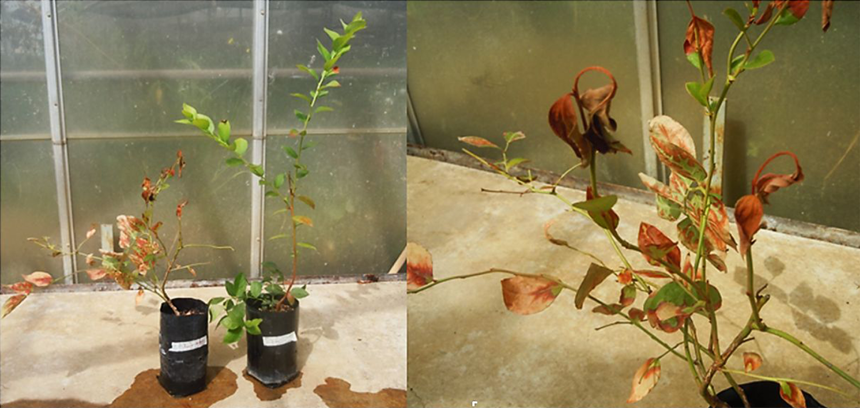E. A. Moya-Elizondo, H. Doussoulin, J. San Martin, and B. Ruiz,
Facultad de Agronomía, Universidad de Concepción,
Chillán, Chile;
P. Del Valle, Departamento de Calidad y Postcosecha,
Hortifrut Chile S.A.,
Huechuraba, Chile.
Published online: 15 Aug 2019 | https://doi.org/10.1094/PDIS-02-19-0275-PDN
Chile is the main exporter of blueberries in the Southern Hemisphere, producing this fruit from October to April each year, when there is no production available in the main markets situated in the northern hemisphere. Chile, with around 15,600 hectares planted with Highbush blueberries along the country, has some crown and root rot diseases, which affect the crops reducing its productivity (Larach et al., 2009). In 2014, blueberry (Vaccinium corymbosum cv. Jolene) plants showed an uncommon severe wilt symptoms (between 90 to 50% of incidence), associated with marginal leaf burn, and brown discoloration on plant crowns, in two orchards of Araucanía Region (38°54′00″S 72°40′00″O) in southern Chile. A fungal specie was consistently isolated by cutting small pieces of symptomatic crowns, sterilizing with 1% sodium hypochlorite and placing them on potato dextrose agar (PDA). Plates were incubated at 25°C for 7 days. To obtain pure fungal cultures, hyphal tips were transferred to PDA. Upon isolation, the colonies formed on PDA developed light aerial mycelium with hints of purple after 7 days. The fungus formed abundant macroconidia and microconidia. The macroconidia were hyaline, slightly sickle-shaped with a foot-shaped basal cell, 3 to 5 septations and 30.34 to 50.67 μm length by 3.22 to 4.58 μm wide. Microconidia were hyaline, and oval-ellipsoid to cylindrical, single-celled and 5.47 to 13.07 μm length by 2.25 to 3.72 μm wide (n = 50). Based on cultural and morphological characteristics, the pathogen was identified as Fusarium oxysporum Schltdl (Leslie and Summerell 2006). Multi-locus approach of four isolates was used to confirm pathogen identity. For that, the ITS region, 18s small subunit rRNA (18s ssu rRNA), and translation elongation factor 1-alpha (tef1-α) genes, were amplified with primers ITS1/ITS4, NS1/NS4 and EF1/EF2 and sequenced. BLAST analysis of the amplified fragments showed that the four isolates were identified as F. oxysporum showing similarity with sequences for ITS (100% identity with accession no. KU986798.1), 18s ssu rRNA (100% identity with accession no. MH269307.1), and tef1-α (99% identity with accession no. KM092478.1) available in the GenBank for this pathogen affecting blueberry and another plant specie.
Additionally, to test Koch’s postulates, the crown section of blueberry plants cv. Jolene (n=10) were inoculated with 200 µl of 1 × 106 conidia/ml suspension on the crown section. Inoculated plants were placed in greenhouse at room temperature (20-25°C) for 30 days. After 2 weeks, inoculated plants produced typical symptoms of Fusarium wilt. No symptoms were observed on the negative control plants. Koch’s postulates were fulfilled after symptom appearance, which were similar to symptoms observed in the field, small pieces (3 × 3 mm) of tissues from the lesion margins were cultured on PDA, and identified based on morphology as F. oxysporum. The experiment was conducted once. Although Fusarium wilt is reported in China (Liu et al. 2014), to our knowledge, this is the first report of Fusarium wilt on blueberry caused by F. oxysporum in Chile, and this pathogen should be considered among the possible crown and root rot pathogens affecting this important berry crop in the country.

References
Larach, A., Besoaín, X., and Salgado, E. 2009. Crown and root rot of highbush blueberry caused by Phytophthora cinnamomi and P. citrophthora and cultivar susceptibility. Cienc. Inv. Agr. 36 (3): 433-442. http://dx.doi.org/10.4067/S0718-16202009000300010.
Leslie, J. F. and Summerell, A. 2006. The Fusarium Laboratory Manual. Blackwell
Publishing, Ames.
Liu, Y. H., Lin, T., Ye, C. S., and Zhang, C. Q. 2014. First Report of Fusarium Wilt in Blueberry (Vaccinium corymbosum) Caused by Fusarium oxysporum in China. Department of Crop Protection, Zhejiang Agriculture and Forest University, China. APS Disease Notes. 98, 8; 1158.
